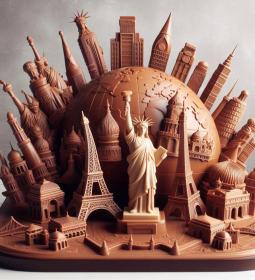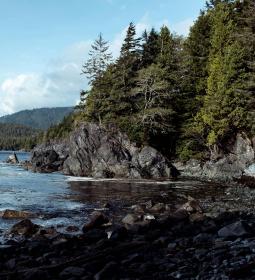It's easy to be famous when you're big. Everyone knows Philip Kirkorov or Nikolai Valuev. Or else: everyone knows that Russia is the largest country in the world and occupies one seventh of the inhabited land. Or China, which boasts the second largest economy and the largest population.
It's another matter if you have a small territory, not very many people, modest financial resources. Is it easy to be small? Take a look at the top 10 smallest countries in the world and decide for yourself.
Vatican
The most modest sovereign state in the world, both in area (44 hectares) and in population (about 1000 people), is proof that small size is not at all equal to insignificance or uninteresting - another nuclear power can envy the influence of the Holy See. "How many divisions does the Pope have?" - Joseph Stalin was curious. We know the answer - three companies of the palace guard and one and a half billion Catholics. The Vatican also boasts the Basilica of St. Peter, a great Baroque masterpiece, the Sistine Chapel, hand-painted by Michelangelo, and the world's richest art collection. It also houses the world's first library "for official use" - a repository of forbidden and heretical books at the former congregation of the Holy Inquisition.
Monaco
This miniature state formation on the French Riviera covers just over two square kilometers (the territory grows thanks to land drainage), but is the most densely populated in the world. The concentration of attractions is also amazing: museums, cathedrals, a couple of dozen gardens and parks, an oceanographic museum, the world's most famous casinos and the most sophisticated Formula 1 track in terms of route.
Tuvalu
This sleepy kingdom, consisting of 3 volcanic islands and 6 atolls, occupies some 26 square kilometers. It is located halfway between the Australian state of Queensland and Hawaii and is so far from civilization that, God forbid, 2000 tourists come here a year.
There are no monuments or attractions here, but tourists who prefer eco-friendly recreation, modest accommodation and a complete absence of cruises, tours, excursions and the like will be happy to have the opportunity to wander through the palm groves and dive with a mask and snorkel in the blue lagoon (they are all blue ).
Republic of San Marino
According to legend, San Marino was founded in 301 - then it is the oldest existing sovereign state in the world, the last independent state of Italy and the first republic in the world.
A little over sixty kilometers of sovereignty are packed with a couple of cities, a few dozen villages, harsh mountain landscapes and a couple of castles. The capital of the same name is included in the UNESCO World Heritage List. To get a better idea of the history of the country, we recommend visiting the Museum di Stato.
Liechtenstein
This relic of German feudalism is located high in the mountains, sandwiched between Austria and Switzerland in the Rhine Valley, making it extremely attractive for those wishing to go skiing, biking (mountain again) or wandering in the mountains on foot. Vaduz Castle dates back to the 12th century and is incredible, but closed to the public.
Republic of the Marshall Islands
Formally independent, this Pacific country is an associated state with the United States: the US government invests in the local economy and maintains the exchange rate.
There are over 1000 islands and 29 coral atolls; one of them, Bikini, not only gave the name to the swimsuit, but also opened its hospitable arms for the American nuclear test site. This is a Mecca for diving - in the waters of the atoll there are several dozen sunken ships from the Second World War, including a couple of aircraft carriers. There is also great fishing and surfing - no worse than the Great Barrier Reef.
Republic of Nauru
The smallest island state and republic is located on a ring atoll in the middle of the Pacific Ocean. Nauru has no beaches or decent tourist infrastructure, and the only tourist interest here is the ruins of Japanese military fortifications from the Second World War.
Federation of Saint Kitts and Nevis
The Caribbean state, informally known as Saint Kitts and Nevis, is the smallest country in the Western Hemisphere, headed by Queen Elizabeth II. Top attractions include beautiful reef-sheltered beaches, dormant volcanoes such as Mount Liamuiga and Mount Nevis, pristine rainforests, colonial-era cities and the stunning Sulfur Hill Fortress. Nevis is a quieter, even patriarchal place, where you can see plantations and botanical gardens.
Maldives
The smallest country in Asia - both in population and area - consists of many islands in the vast areas of the Indian Ocean. Its highest natural point is only 5 meters above the waves, making it an extremely unfortunate place to live due to global warming. It is best known for its snorkeling and scuba diving, dazzling white sand beaches and luxury resorts. Although some local hotels are fairly affordable, Maldives is a good option for budget travelers as well.
Malta
The tenth largest country in the world is made up of several small islands that for centuries have been the arena for the struggle for dominance between the great Mediterranean powers. The main islands - Malta and Gozo - became home to the Catholic Order of the Knights-Crusader Hospitallers. Despite its small size, the island boasts three World Heritage Sites, including megalithic temples dating back 3,000 years. BC, and the sumptuous architecture of the Renaissance, the crown jewel of which is the capital of the island, La Valletta.













